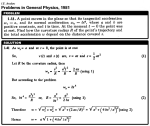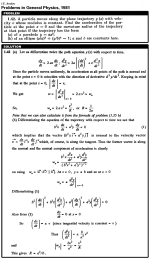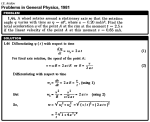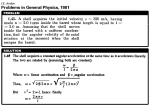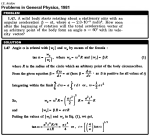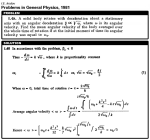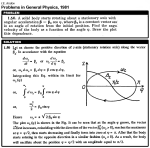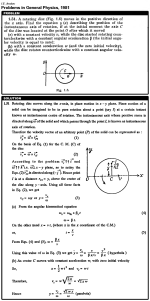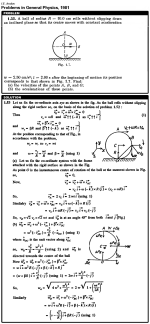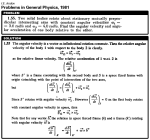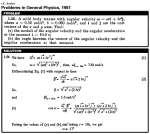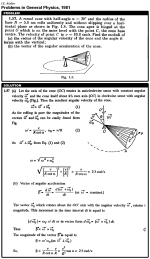| № |
Condition |
free/or 0.5$ |
| 41 | A point moves in the plane so that its tangential acceleration wτ = a, and its normal acceleration wn = bt4, where a and b are positive constants, and t is time. At the moment t = 0 the point was at rest. Find how the curvature radius R of the point s trajectory and the total acceleration w depend on the distance covered s. |
|
| 42 | A particle moves along the plane trajectory y(x) with velocity v whose modulus is constant. Find the acceleration of the particle at the point x = 0 and the curvature radius of the trajectory at that point if the trajectory has the form (a) of a parabola y = ax2; (b) of an ellipse (x/a)2 + (y/b)2 = 1; a and b are constants here. |
|
| 43 | A particle A moves along a circle of radius R = 50 cm so that its radius vector r relative to the point O (Fig. 1.5) rotates with the constant angular velocity ω = 0.40 rad/s. Find the modulus of the velocity of the particle, and the modulus and direction of its total acceleration. |
|
| 44 | A wheel rotates around a stationary axis so that the rotation angle φ varies with time as φ = at2, where a = 0.20 rad/s2. Find the total acceleration w of the point A at the rim at the moment t = 2.5 s if the linear velocity of the point A at this moment v = 0.65 m/s. |
|
| 45 | A shell acquires the initial velocity v = 320 m/s, having made n = 2.0 turns inside the barrel whose length is equal to l = 2.0 m. Assuming that the shell moves inside the barrel with a uniform acceleration, find the angular velocity of its axial rotation at the moment when the shell escapes the barrel. |
|
| 46 | A solid body rotates about a stationary axis according to the law φ = at - bt3, where a = 6.0 rad/s and b = 2.0 rad/s3. Find: (a) the mean values of the angular velocity and angular acceleration averaged over the time interval between t = 0 and the complete stop; (b) the angular acceleration at the moment when the body stops. |
|
| 47 | A solid body starts rotating about a stationary axis with an angular acceleration β = at, where a = 2.0*10-2 rad/s3. How soon after the beginning of rotation will the total acceleration vector of an arbitrary point of the body form an angle α = 60° with its velocity vector? |
|
| 48 | A solid body rotates with deceleration about a stationary axis with an angular deceleration β ∼ sqrt(ω) where ω is its angular velocity. Find the mean angular velocity of the body averaged over the whole time of rotation if at the initial moment of time its angular velocity was equal to ω0. |
|
| 49 | A solid body rotates about a stationary axis so that its angular velocity depends on the rotation angle φ as ω = ω0 - aφ, where ω0 and a are positive constants. At the moment t = 0 the angle φ = 0. Find the time dependence of (a) the rotation angle; (b) the angular velocity. |
|
| 50 | A solid body starts rotating about a stationary axis with an angular acceleration β = β0 cos φ, where β0 is a constant vector and φ is an angle of rotation from the initial position. Find the angular velocity of the body as a function of the angle φ. Draw the plot of this dependence. |
|
| 51 | A rotating disc (Fig. 1.6) moves in the positive direction of the x axis. Find the equation y(x) describing the position of the instantaneous axis of rotation, if at the initial moment the axis C of the disc was located at the point O after which it moved (a) with a constant velocity v, while the disc started rotating counterclockwise with a constant angular acceleration β (the initial angular velocity is equal to zero); (b) with a constant acceleration w (and the zero initial velocity), while the disc rotates counterclockwise with a constant angular velocity ω. |
|
| 52 | A point A is located on the rim of a wheel of radius R = 0.50 m which rolls without slipping along a horizontal surface with velocity v = 1.00 m/s. Find: (a) the modulus and the direction of the acceleration vector of the point A; (b) the total distance s traversed by the point A between the two successive moments at which it touches the surface. |
|
| 53 | A ball of radius R = 10.0 cm rolls without slipping down an inclined plane so that its center moves with constant acceleration w = 2.50 cm/s2; t = 2.00 s after the beginning of motion its position corresponds to that shown in Fig. 1.7. Find: (a) the velocities of the points A, B, and O; (b) the accelerations of these points. |
|
| 54 | A cylinder rolls without slipping over a horizontal plane. The radius of the cylinder is equal to r. Find the curvature radii of trajectories traced out by the points A and B (see Fig; 1.7). |
|
| 55 | Two solid bodies rotate about stationary mutually perpendicular intersecting axes with constant angular velocities ω1 = 3.0 rad/s and ω2 = 4.0 rad/s. Find the angular velocity and angular acceleration of one body relative to the other. |
|
| 56 | A solid body rotates with angular velocity ω = ati + bt2j, where a = 0.50 rad/s2, b = 0.060 rad/s3, and i and j are the unit vectors of the x and y axes. Find: (a) the moduli of the angular velocity and the angular acceleration at the moment t = 10.0 s; (b) the angle between the vectors of the angular velocity and the angular acceleration at that moment. |
|
| 57 | A round cone with half-angle α = 30° and the radius of the base R = 5.0 cm rolls uniformly and without slipping over a horizontal plane as shown in Fig. 1.8. The cone apex is hinged at the point O which is on the same level with the point C, the cone base centre. The velocity of point C is v = 10.0 cm/s. Find the moduli of (a) the vector of the angular velocity of the cone and the angle it forms with the vertical; (b) the vector of the angular acceleration of the cone. |
|
| 58 | A solid body rotates with a constant angular velocity ω0 = 0.50 rad/s about a horizontal axis AB. At the moment t = 0 the axis AB starts turning about the vertical with a constant angular acceleration β0 = 0.10 rad/s2. Find the angular velocity and angular acceleration of the body after t = 3.5 s. |
|
| 59 | An aerostat of mass m starts coming down with a constant acceleration w. Determine the ballast mass to be dumped for the aerostat to reach the upward acceleration of the same magnitude. The air drag is to he neglected. |
|
| 60 | In the arrangement of Fig. 1.9 the masses m0, m1, and m2 of bodies are equal, the masses of the pulley and the threads are negligible, and there is no friction in the pulley. Find the acceleration w with which the body m0 comes down, and the tension of the thread binding together the bodies m1 and m2, if the coefficient of friction between these bodies and the horizontal surface is equal to k. Consider possible cases. |
|
